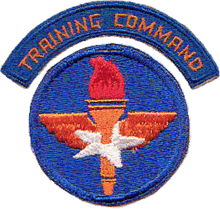Flying Division, Air Training Command
Flying Division, Air Training Command is an inactive United States Air Force unit. It was last assigned to Air Training Command, stationed at Randolph Air Force Base, Texas. It was inactivated on 14 November 1949.
| Flying Division, Air Training Command | |
|---|---|
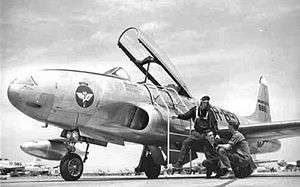 Postwar T-33A Shooting Star jet fighter training | |
| Active | 1926–1949 |
| Country | |
| Branch | |
| Type | Command and Control |
| Role | Training |
| Part of | Army Air Forces Training Command Air Training Command |
| Engagements | World War II
|
| Commanders | |
| Notable commanders | 1940 Oct 4[1]-1941 Oct 22: Gerald C. Brant 1941 Oct 23-1941 Nov 30: Frank P. Lahm[2] 1941 Dec 1-1942 Sep: Hubert R. Harmon 1942 Sep-1943 Jul 31: tbd |
| Insignia | |
| Flying Division, Air Training Command emblem | 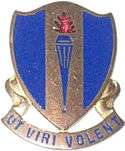 |
The organization was initially organized in 1926 as the main pilot training organization for the Army Air Corps. It was later one of three training commands by the Office of the Chief of Air Corps in 1940 to accommodate the large number of Air Cadets being recruited due to the expansion of the Army Air Corps after the Fall of France. During World War II, thousands of cadets were in training at various flight schools across the Central United States being trained as pilots for fighters, bombers and transports. The command also trained the navigators, bombardiers and gunners necessary for the bombers to attack enemy targets in the combat areas overseas. After World War II ended, it became the primary pilot and aircrew training organization for Air Training Command during the postwar years.
History
With the demobilization of the Air Service after World War I, the Army's air arm remained quite small during most of the interwar period.[3]
Army Air Service
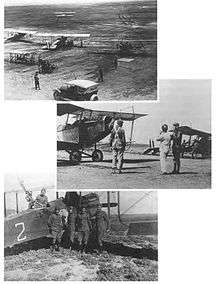
Primary flight training was held only at March Field in California and Carlstrom Field in Florida. The pilot school course combined ground school and elementary flight training. Cadets flew training flights in wartime surplus Curtiss JN-4D Jennies and also deHavilland DH-4s. The first class of cadets at both March and Carlstrom were enlisted men from various Air Service units. Civilians constituted most of the second class. Advanced training was held at Post Field, Fort Sill, Oklahoma for observers and pilots. Pursuit and bombardment training took place at Kelly Field.[4]
On 4 June 1920, the National Defense Act of 1920 took effect and the United States Army Air Service was statutorily recognized as the combatant air arm of the United States Army. At the time, the Air Service had 1,155 Regular officers; by year’s end there were 975. Of that number, only 642 were pilots.[4]
The Training and Operations Group of the Air Service had hoped to graduate thirty men per month, but in the last six months of 1920, Carlstrom had graduated thirty-six officers and fifty-six cadets; March had graduated twenty-five officers and sixty-seven cadets. A number of the students in the early class, especially at Carlstrom Field, were naval officers not destined for Army squadrons. However neither of the primary pilot schools had executive officers and that Carlstrom did not even have an Officer in Charge of Flying. The schools keenly felt the critical shortage of manpower. They did not have enough enlisted mechanics to keep the airplanes fully operational. Too few instructors remained in the service to teach students, assuming that students could be recruited in reasonable numbers.[4]
For a time after the war, the commissioned grades of the Air Service held no vacancies. Furthermore, Congress forbade new Army enlistments in early 1921, which effectively curtailed training new cadets.
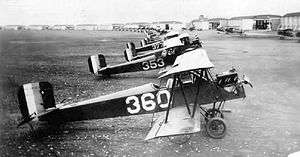
It was decided to close March and Carlstrom and consolidate all flight training at Brooks and Kelly Fields. By 1 September 1922, the Air Service Primary Flying School 11th School Group was operational at Brooks; the Advanced Flying School 10th School Group was operational at Kelly Field. Students graduating the primary flying school at Brooks Field went on to the Advanced Flying School at Kelly Field.[4]
To be eligible to enter flight training, a candidate had to be an unmarried male citizen of the United States between the ages of twenty and twenty-seven and have a high school diploma or its equivalent. Applicants took a physical and educational examination, and those accepted were assigned to a primary flight school class at Brooks Field. Until 1926, most students learned to fly on the JN-6H. The Advanced Flying School divided its system of instruction into basic and advanced phases. Basic training continued the staged instruction of primary training in which all students worked through increasingly difficult maneuvers. Advanced students spent approximately twelve weeks performing, figure-eights, 180- and 360-degree turns, performance flights, formations, and cross-country and night flying. The students were then moved into specialized flying of observation, bombing, pursuit, or attack aircraft.[4]
Air Corps Training Center
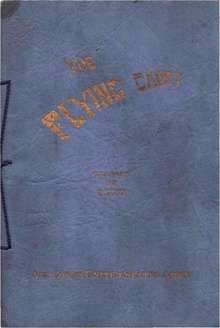
Flying Division, Air Training Command's origins begin in 1922 when the Army Air Service consolidated its center for primary training at Brooks Field, Texas, and its advanced center at Kelly Field, Texas. In the era after World War I, each phase of instruction lasted about six months, with the school at Kelly being divided into three months of basic and advanced instruction. With the decision by the Coolidge Administration to expand the Air Service, the Army established the Air Corps Training Center in San Antonio, with the two fight schools, and adding the School of Aviation Medicine at Brooks Field.[3]
As the new center began to carry out its mission of improving supervision of flying training, it discovered that the facilities in the San Antonio area were insufficient to accommodate the expanded number of cadets entering primary training. Hence, primary pilot training resumed at March Field, California, from 1927 to 1931.[3]
The decision in 1927 to continue the system of a hierarchy of training schools led to the search for another primary flying field close to the hub of activity and the good weather in Texas. The investigation resulted in selection of an area seventeen miles northeast of San Antonio. Opened on 1 January 1931, Randolph Field was trumpeted as the "West Point of the Air".[5]
With the opening of Randolph Field primary flight training was transferred from March to the new facility there. The Air Corps Training Center at Randolph Field was in charge of the entire Army pilot training program in the United States from 1931 to 1939. The Center developed an efficient, well-coordinated flying training program that focused on the quality of its pilots. It was not only critical to the development of military flight training, but also to the training of American pilots, who after graduation spread out over the world, some to commercial airline jobs in Latin America and the Philippines, others to government or industry occupations that took them to Europe and Asia. However, the program only produced about 200 pilots a year.[6]
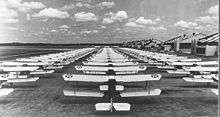
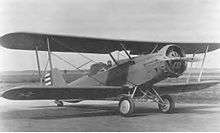
The size of its aircraft inventory and the number of airmen who trained at Randolph Field failed to equal the compound’s magnificence. By 1934 the school could graduate 150 cadets a year, although it had increased the number of flying hours by thirty-five and expanded the syllabus. Between the time in October 1931, when the first school troops reported to Randolph from the old primary schools at Brooks and March Fields, and 1 March 1935, when GHQ Air Force took form, slightly more than 2,000 would-be pilots reported to the Primary Flying School. Cadets constituted approximately 75 percent of the students reporting, and nearly 47 percent graduated.[7]
The creation of the GHQ Air Force made 1935 a banner year, as the air arm moved a step closer to that longed-for reality. GHQAF gave the Chief of the Air Corps responsibility for overseeing individual training at the flying schools. The Training Section reviewed the programs of instruction at the Primary and Advanced Flying Schools, the Air Corps Tactical School, and the Air Corps Technical School; reviewed training programs submitted by the War Department; supervised preparation and revision of pertinent training materials including manuals, regulations, circulars, and films; maintained various types of training records and statistics; and reviewed and recommended matters concerning the training of the National Guard and Air Reserve.[8]
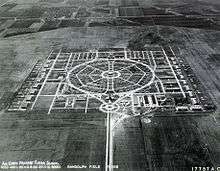
In late 1937 Chief of the Air Corps Maj. Gen. Oscar Westover submitted to the General Staff a statement of Air Corps objectives that ratified pilot specialization and pinpointed desired stops in the now-established professional educational system along an upward path toward promotion and leadership. Following graduation from the Training Center, all officers would join a tactical unit for at least two years. Thereafter individuals might compete for additional education and training.[9]
In 1939 only two Air Corps flying schools were operating, Randolph Field and, for advanced training, Kelly Field with Brooks as a subpost.[3][10] Beginning in 1939, the Air Corps contracted primary flight training to civilian schools, and Randolph Field's mission shifted to basic pilot training. It was General Arnold's belief that by turning over the responsibility for primary training to other agencies, he could free the Air Corps to concentrate its full resources on later phases of training, and thus in effect expand the capacity.[11]
World War II
- See also: Army Air Forces Training Command
On 24 May 1940, General Henry H. Arnold submitted a plan to the War Department for 3 training centers.[12]:131 When the new centers for the West Coast (HQ at Moffett Field CA) and Southeast (Maxwell Field AL) were established[13] on 22 August 1940; the existing "Air Corps Training Center" was redesignated the Gulf Coast Air Corps Training Center.[14] Funding of a 30,000-pilot training program was approved on 5 April 1941, and included new GCACTC bases at "Enid, Okla.; Perrin Field, Sherman, Tex.; Waco, Tex.; Moore Field, Mission, Tex.; Lubbock, Tex.; Midland, Tex.; and Lake Charles, La."[12] In 1941, "thirty-two major flying fields comprise[d] the Gulf Coast Air Corps Training Center" for basic and advanced flying training[15] plus 16 civilian flight schools by October (a bombing range was also part of the center).[10]
_-_Map.png)
NOTE: Marfa Army Airfield, Pecos Army Airfield, & Wink Field in West Texas were part of the West Coast ACTC.
The Central Instructors School began at Randolph in January 1942,and the first "flying sergeants" graduated as combat pilots in May 1942 "at a civil contract flying school in the Gulf Coast Air Corps Training Center"[3]
On 26 September 1942, the GCACTC's Advanced Twin Engine and Bombardier Training Center at Midland, Texas, was redesignated Midland Army Airfield's Army Air Forces Bombardier School (colloq. Bombardier College) which operated 23 bombing ranges in West Texas[16] (the school had moved to Albuquerque Army Air Base by 28 February 1945).[17][18]
In conjunction with the USAAF Flying Training Command merging with the Technical Training Command;[19] on 31 July 1943, the Gulf Coast Air Corps Training Center was redesignated as the Central Flying Training Command when the GCACTC schools were consolidated with the separate navigator training (4 schools including 1 at Ellington Field that had been a bombardier school) and .[20] The consolidation supported the January 1943 Casablanca Conference decision regarding air power in the European Theatre and the resulting "Combined Bomber Offensive from the United Kingdom" plan, which required aircrews for 4 development phases (944, 1192, 1746, & 2702 bombers) through 31 March 1944.[21]:15
By 1944, Central Flying Training Command (CFTC) controlled a large number of training schools in the Southwestern United States, and established several Wings to provide organizational command and control over them, based on both training types and geography. The schools operated by CFTC part of the Aviation Cadet Training Program. These were:[3]
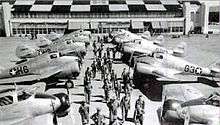
- Classification: This was the stage where it would be decided whether the cadet would train as a navigator, bombardier, or pilot
- Preflight: Ground training for all air cadets. Successful completion meant being assigned to a flying school for training. "Washouts" were returned to the regular Air Corps ranks for reassignment.
- Primary (Phase I): Taught basic flying using two-seater training aircraft. Usually taught by contract flying schools operated by the WFTC
- Basic (Phase II): Formation flying, air navigation, cross-country flying skills were taught.
- Advanced (Phase II): Single or multi-engine aircraft schools for cadets becoming fighter, bomber or transport pilots. After graduation, the successful Air Cadet received his "wings" and were commissioned Second Lieutenants. In addition, experienced pilots in the field were sent to Training Command "transition schools" to acquire additional single or multi-engine flying ratings.
In addition to the American Air Cadets, Cadets from the British Royal Air Force and Free French Air Force were trained in flying skills. CFTC also operated aircrew schools for Navigators, Bombardiers and flexible aerial gunners. Radio operators were centrally trained at Scott Field, Illinois. Other aircrew positions, such as B-29 flight engineers and RADAR operators were also trained later in the war as training requirements presented themselves. This included the first jet pilots in 1945.[3]
Postwar era
Shortly after the end of World War II on 15 December 1945, Central Flying Training Command consolidated with Western Flying Training Command on 1 November 1945, and was re-designated Western Flying Training Command. This reflected the massive demobilization after the end of the war, and the closure of the majority of the wartime training bases.[3]
On 15 December 1945 Western Flying Training Command consolidated with the Eastern Flying Training Command. The single entity became Army Air Forces Flying Training Command on 1 January 1946, with its headquarters at Randolph Field, Texas. On 1 November 1946 the Flying Training Command was re-designated as the Flying Training Division of the new Air Training Command, established as part of the postwar reorganization of the Army Air Forces.[3]
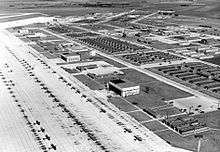
By 1946, all the wartime Flying Training Wings were disbanded, and command and control was consolidated into the Flying Training Division. The flight schools at the bases which remained open were consolidated into the Army Air Forces (later Air Force) base units. After the establishment of the United States Air Force in September 1947 and the implementation of the Hobson Wing-Base plan in 1948, the Base Units were discontinued, and ATC established new Pilot Training Wings at each base. This new plan made the training organizations uniform with the other major commands throughout the Air Force.[3]
In addition, the pilot training program was consolidated into two classes, Basic and Advanced. Also, the wide variety of training aircraft were reduced to streamline the training program. Jet training aircraft and courses were also added, along with helicopter training as the new wartime technologies were added into the postwar Air Force inventory as fully operational weapons systems.[3]
Austere postwar military budgets led to additional consolidations and all of the flying programs suffered from
shortages of aircraft replacement parts, qualified maintenance personnel, and instructors—problems that existed been with the schools throughout the postwar era. The last half of 1949 was an exercise in austerity. President Harry S. Truman decided that the country could only afford a 48-group Air Force. With only a minimum of operating funds available, the Secretary of Defense directed major spending cuts throughout the Department of Defense (DOD). In a re-organization, Flying Division, Air Training Command was inactivated on 14 November 1949 when Air Training Command absorbed its subordinate Divisions into its command organization to comply with the budget reduction directive.[3]
Lineage
- Constituted as the Air Corps Training Center
- Activated on 1 September 1926
- Redesignated Gulf Coast Air Corps Training Center on 8 July 1940
- Redesignated Army Air Forces Gulf Coast Training Center on 29 October 1942
- Redesignated Central Flying Training Command on 31 July 1943
- Redesignated Western Flying Training Command on 15 December 1945
- Redesignated Army Air Forces Flying Training Command on 1 January 1946
- Redesignated Flying Division, Air Training Command on 1 July 1946
- Inactivated on 14 November 1949[3]
Assignments
- Office of the Chief of Air Corps, 1 September 1926
- Air Corps Flying Training Command (later Army Air Forces Flying Training Command, Army Air Forces Training Command, Air Training Command), 23 January 1942 – 14 November 1949[3]
Stations
- San Antonio, Texas, 1 September 1926
- Randolph Field (later Randolph Air Force Base), Texas, 1 January 1931 – 14 November 1949[3]
Major Components
Inter-war years
|
|
*All primary flying school units consolidated at Randolph Field, 31 December 1931
World War II
|
|
Postwar
- Randolph Field (later Air Force Base), Texas
- 2532d Army Air Forces (later Air Force) Base Unit
- 3510th Pilot Training Wing (Basic)[3]
- Barksdale Field (later Air Force Base), Louisiana[31]
- 331st Army Air Forces (later Air Force) Base Unit
- 3500th Pilot Training Wing (Advanced, Multi-Engine)[3]
- Goodfellow Field (later Air Force Base), Texas[32]
- 2533d Army Air Forces Base Unit
- 3545th Pilot Training Wing (Basic)[3]
- Mather Field (later Air Force Base), California
- 1505th Army Air Forces (later Air Force) Base Unit
- 3535th Bombardier Training Wing [3]
- Las Vegas Field (later Air Force Base), Nevada[33]
- 3006th Army Air Forces Base Unit
- 3595th Pilot Training Wing (Advanced, Single-Engine)[3]
- San Marcos Field, Texas (later Air Force Base[34]
- 2456th Army Air Forces (later Air Force) Base Unit
- 3585th Pilot Training Wing (Liaison-Helicopter)[3]
- Perrin Field (later Air Force Base), Texas[35]
- 2621st Army Air Forces Base Unit
- 3585th Pilot Training Wing (Basic)[3]
- Waco Field (later Air Force Base), Texas[36]
- 2543d Army Air Forces Base Unit
- 3565th Pilot Training Wing (Basic)[3]
- Enid Field (later Air Force Base), Oklahoma[37]
- 2518th Army Air Forces Base Unit
- 3575th Pilot Training Wing (Advanced, Multi-Engine)[3]
- Williams Field (later Air Force Base), Arizona
- 3010th Army Air Forces (later Air Force) Base Unit
- 3525th Pilot Training Wing (Advanced, Single-Engine)[3]
Major Aircraft
Inter-war years
- Primary trainers
- Consolidated PT-1, 1921–1928
- Consolidated PT-3 (PT-11, PT-12), 1927–1937
- Boeing-Stearman PT-13, 1937-[6]
- Basic trainers
- Curtiss-Wright (de Havilland) DH-4 1921-1932
- Douglas O-2K (Converted to BT-1), 1930-
- Douglas O-32A (Converted to BT-2), 1930-[6]
- Advanced trainers
- Curtiss P-1 Hawk (Converted to AT-4, AT-5), 1926-[6]
World War II
- Primary flight training
- Boeing-Stearman PT-17, Fairchild PT-19 and Ryan PT-22 twin-seat, single engine trainers[3]
- Basic flight training
- Vultee BT-13 and Vultee BT-15[3]
- Advanced flight training
- North American AT-6 (single engine); Cessna AT-17 (two-engine)[3]
- Specialized schools:
- Curtiss-Wright AT-9s were used for high performance two-engine training in preparation for Lockheed P-38 Lightning training
- Beechcraft AT-10s were used for pilots in training for two engine bombers (B-25s and B-26s)
- Beechcraft AT-11s were used for pilots in training for C-47 transports along with bombardier training
- Beechcraft AT-7s were used for two-engine pilot training and also navigator training
- Boeing B-17s and Consolidated B-24s were used for four-engine pilot training
- L-2, L-3, L-4, TG-5 and TG-6s were used for glider and liaison pilot training
- Gunnery training schools flew A-33, AT-6s, AT-1s, B-34s, B-10s and RP-63s for air-to-air flexible gunnery training.[3]
Postwar
|
|
See also
- World War I training fields of the Air Service, United States Army
References
![]()
- https://news.google.com/newspapers?id=9XRFAAAAIBAJ&sjid=ibwMAAAAIBAJ&pg=5823,6020388&dq=gulf-coast-air-corps-training-center&hl=en
- "New Replacement Center for Airmen to Open on Nov. 12". The Victoria Advocate. Victoria, Texas. 6 November 1941. Retrieved 3 June 2012.
- Manning, Thomas A. (2005), History of Air Education and Training Command, 1942–2002. Office of History and Research, Headquarters, AETC, Randolph AFB, Texas ASIN: B000NYX3PC
- Cameron, Rebecca Hancock, 1999, Training to Fly. Military Flight Training 1907-1945, Chapter 4: Training at home for War Overseas. Air Force History and Museums Program, Air Force Historical Research Agency, Maxwell AFB, Alabama
- Cameron, p252
- Maurer, Maurer (1987). Aviation in the U.S. Army, 1919–1939, Office of Air Force History, Washington, D.C. ISBN 1-4102-1391-9
- Cameron, p253
- Cameron, p274
- Cameron, p275
- https://news.google.com/newspapers?id=FJhSAAAAIBAJ&sjid=-TUNAAAAIBAJ&pg=1409,5812249&dq=gulf-coast-air-corps-training-center&hl=en
- The Army Air Forces in World War II: Chapter 14 THE FOUNDATIONS OF A WAR TRAINING PROGRAM
- The Army Air Forces in World War II Volume VI: Men and Planes: Chapter 4. Ibiblio.org. Retrieved on 2013-09-18.
- "War Department Names Moffett Training Center". San Jose News. 15 July 1940. Retrieved 4 June 2012.
- "Life of Pioneer Airman will be Enacted on Air". The Victoria Advocate. 28 November 1941. Retrieved 4 June 2012.
- Valentine, Harvey E. (17 August 1941). "New Army Air Schools" (Article Preview). The New York Times. Retrieved 4 June 2012.
- Colwell, James L. "Midland Army Air Field". Texas State Historical Association. Retrieved 13 June 2012.
In August 1943 the AAF Central Bombardier Instructor School was transferred from Carlsbad, New Mexico, to Midland ... the "West Texas Bombardier Triangle" of bases at Big Spring (1942), San Angelo (1942), and Childress (1943), and were instrumental in developing photographic and sonic methods of scoring bomb hits and analyzing bombing proficiency
-

- Google Drive Viewer. Docs.google.com. Retrieved on 2013-09-18.
- NATIONAL REGISTER OF HISTORIC PLACES HISTORIC CONTEXT AND EVALUATION FOR KIRTLAND AIR FORCE BASE Albuquerque, New Mexico Archived 1 June 2013 at the Wayback Machine
- Craven, Wesley Frank; Cate, James Lea, eds. (1949). "Chapter 17: Individual Training of Flying Personnel". The Army Air Forces in World War II (Terry Welshan webpage transcription)
|format=requires|url=(help). Chicago: University of Chicago Press. ISBN 1-4289-1587-7. OCLC 9828710. Retrieved 4 June 2012.by May 1943 there were fifty-six contract primary schools in operation. At each school the AAF maintained a small military contingent whose services were gradually expanded, but the military element in the activity of these schools was subordinated to the task of learning to fly.
- Stormont, John F. (Capt) (March 1946) [1945 summer], The Combined Bomber Offensive: April through December 1943, AAF Historical Office; Headquarters, Army Air Force (available at the Dwight D. Eisenhower Presidential Library in the "Collection of 20th Century Military Records, 1918–1950 Series I"; Historical Studies Box 35).
- Clay, Steven E. (2011). US Army Order of Battle 1919–1941. 3 The Services: Air Service, Engineers, and Special Troops 1919–1941. Fort Leavenworth, KS: Combat Studies Institute Press. ISBN 978-0-9841901-4-0. LCCN 2010022326. OCLC 637712205
- 31st Flying Training Wing, lineage and history document Air Force Historical Agency, Maxwell AFB, Alabama
- 32d Flying Training Wing, lineage and history document Air Force Historical Agency, Maxwell AFB, Alabama
- 33d Flying Training Wing, lineage and history document Air Force Historical Agency, Maxwell AFB, Alabama
- 34th Flying Training Wing, lineage and history document Air Force Historical Agency, Maxwell AFB, Alabama
- 77th Flying Training Wing, lineage and history document Air Force Historical Agency, Maxwell AFB, Alabama
- 78th Flying Training Wing, lineage and history document Air Force Historical Agency, Maxwell AFB, Alabama
- 79th Flying Training Wing, lineage and history document Air Force Historical Agency, Maxwell AFB, Alabama
- 80th Flying Training Wing, lineage and history document Air Force Historical Agency, Maxwell AFB, Alabama
- Conducted flying training and was HQ AAFTC location from 25 February 1946 until 17 October 1949; transferred to Strategic Air Command
- Inactive 1 July 1946 – 1 December 1947
- Inactive 28 August 1946 – 1 April 1948
- Inactive 30 November 1945 – 1 May 1946; Closed 1 March 1949
- Inactive 31 October 1946 – 1 April 1948
- Inactive 15 December 1945 – 1 October 1948
- Inactive 31 January 1947 – 1 August 1948
